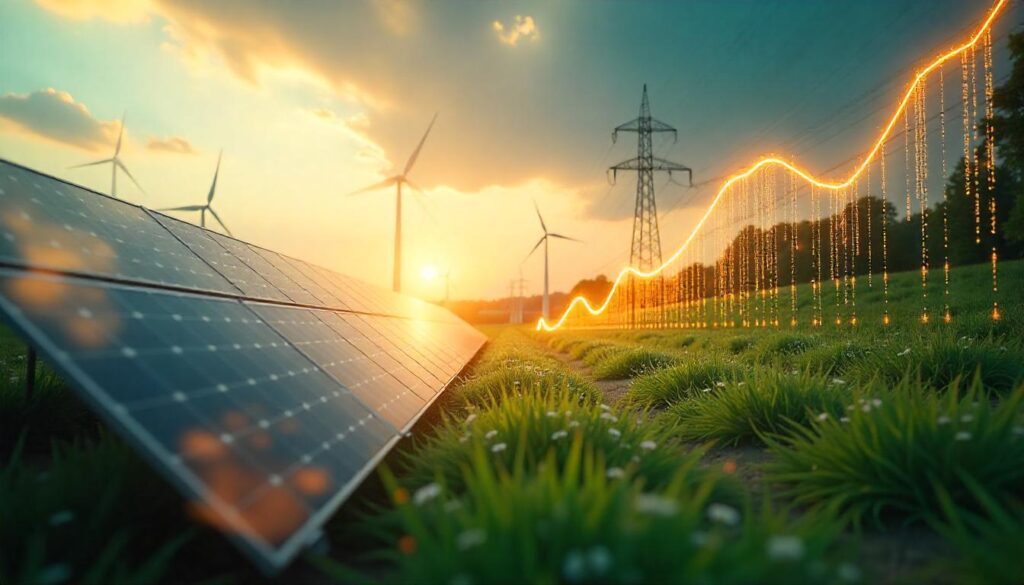Global Energy Investment to Hit Record $3.3 Trillion in 2025: Clean Energy Dominates

IEA: Global Energy Investment Soars to Record $3.3 Trillion in 2025, Driven by Clean Energy Tidal Wave
PARIS, France – June 12, 2025 – The world’s energy landscape is undergoing a profound transformation, with global investment in energy set to reach an unprecedented $3.3 trillion in 2025, according to the latest “World Energy Investment 2025” report from the International Energy Agency (IEA). This staggering figure, representing a 2% increase in real terms from 2024, is overwhelmingly propelled by a historic surge in capital flowing into clean energy technologies, now attracting double the investment directed towards fossil fuels.
The IEA’s findings paint a clear picture: the global energy transition is accelerating, shifting decisively towards an electrified, cleaner future. This record investment is a testament to the growing urgency of energy security, the economic competitiveness of renewables, and robust policy support worldwide.
- IEA: Global Energy Investment Soars to Record $3.3 Trillion in 2025, Driven by Clean Energy Tidal Wave
- Clean Energy Takes Center Stage: $2.2 Trillion Bet on a Sustainable Future
- Fossil Fuels: Persistence Amidst Transition
- The Forces Driving Record Investment
- The “Age of Electricity”: A Profound Shift
- Frequently Asked Questions (FAQs) About Global Energy Investment in 2025
- Q1: What is the total projected global energy investment for 2025, according to the IEA?
- Q2: How much of this investment is directed towards clean energy technologies?
- Q3: Which specific clean energy sectors are attracting the most investment?
- Q4: Is investment in fossil fuels decreasing globally?
- Q5: What are the main drivers behind this record global energy investment?
Clean Energy Takes Center Stage: $2.2 Trillion Bet on a Sustainable Future
The report highlights that a remarkable $2.2 trillion—roughly two-thirds of total energy investment—will be channeled into clean energy technologies in 2025. This significant allocation underscores a fundamental pivot in how the world powers itself.
Leading the charge within the clean energy revolution are several key sectors:
- Solar PV: Utility-scale and rooftop solar are set to attract nearly $450 billion, making it the single largest item in global energy investment. Its plummeting costs and versatility continue to make it an irresistible investment.
- Battery Storage: Essential for grid stability and integrating intermittent renewables, investment in battery storage is climbing rapidly, projected to surpass $65 billion in 2025.
- Nuclear Power: Driven by energy security concerns and the appeal of stable baseload power, capital flows into nuclear energy are expected to hit $70-75 billion, marking a 50% growth over the past five years, partially fueled by interest in advanced designs like Small Modular Reactors (SMRs).
- Electricity Grids: Recognizing the vital backbone of a modern energy system, investment in electricity grids is projected at $400 billion. However, the IEA issues a stark warning: this figure is not keeping pace with the explosive growth in clean electricity generation and electrification. Lengthy permitting processes and supply chain bottlenecks for critical components like transformers and cables are hindering necessary upgrades, posing a significant risk to electricity security.
- Beyond Power Generation: The clean energy investment also encompasses crucial areas like low-emissions fuels (including hydrogen, though still nascent at under $30 billion), energy efficiency measures, and the rapidly growing electrification of transport and industry, which sees demand-side investment reaching around $800 billion.
Fossil Fuels: Persistence Amidst Transition
While clean energy dominates, investment in fossil fuels is still substantial, projected at $1.1 trillion in 2025. This reflects ongoing global energy demand and the complexities of transitioning away from deeply entrenched systems.
- Oil & Gas: Upstream oil investment is forecast to see a 6% dip in 2025, the first decline since 2020 (excluding the pandemic-induced slump). However, spending on natural gas and LNG infrastructure remains steady, with major projects in the U.S., Qatar, and Canada set to significantly boost global LNG capacity in the coming years.
- Coal: Despite climate commitments, coal investment is projected to rise again by 4% in 2025, primarily in China and India. This is driven by surging electricity demand that outpaces the rapid deployment of renewables in these large, fast-growing economies.

The Forces Driving Record Investment
Several powerful factors are converging to create this unprecedented wave of energy investment:
- Energy Security Imperative: Geopolitical tensions and market volatility have underscored the need for diverse and secure energy supplies, driving nations to invest heavily in domestic clean energy sources.
- Cost Competitiveness: The dramatic fall in the cost of solar, wind, and battery technologies has made them not just environmentally preferable but also economically superior in many contexts.
- Robust Industrial Policies: Governments worldwide are implementing proactive industrial policies and financial incentives—from the U.S. Inflation Reduction Act to Europe’s Green Deal Industrial Plan and China’s massive green manufacturing push—which are successfully steering capital into cleaner technologies.
- Soaring Electricity Demand: The accelerating pace of digitalization, epitomized by the mushrooming of data centers and the demands of artificial intelligence (AI), is fueling a rapid increase in electricity consumption, necessitating massive investment across all power generation types.
- Climate & Sustainability Goals: Underlying all these drivers is the continued global commitment to achieving net-zero emissions and building a more sustainable future.
The “Age of Electricity”: A Profound Shift
The IEA report emphasizes a historical reversal: a decade ago, fossil fuel investments outpaced electricity-focused investments by 30%. In 2025, electricity investments (generation, grids, and storage) are projected to be 50% higher than total fossil fuel supply spending. This fundamental reorientation signifies that the world has truly entered the “Age of Electricity.”
However, this shift is not without its challenges. The IEA points to a critical imbalance: while investment in clean electricity generation is booming, the crucial spending on grid infrastructure is lagging. This could create bottlenecks, compromise reliability, and slow down the energy transition.
Furthermore, the benefits of this investment boom are not evenly distributed. China continues to dominate global energy investment, particularly in clean energy. In stark contrast, many developing economies, especially in Africa, struggle to mobilize capital, with Africa accounting for just 2% of global clean energy investment despite its vast potential and population. The IEA stresses the urgent need for greater international public finance to unlock private capital in these underserved regions.
In conclusion, 2025 marks a pivotal year for global energy investment. The record $3.3 trillion outlay, overwhelmingly dominated by clean energy, signals an irreversible momentum towards a sustainable future. Yet, the report also serves as a critical reminder that overcoming grid bottlenecks and ensuring equitable investment across all regions will be key to fully realizing the promise of this clean energy tidal wave.
Frequently Asked Questions (FAQs) About Global Energy Investment in 2025
Q1: What is the total projected global energy investment for 2025, according to the IEA?
A: The International Energy Agency (IEA) projects that global energy investment will reach a record $3.3 trillion in 2025, marking a 2% increase in real terms from 2024.
Q2: How much of this investment is directed towards clean energy technologies?
A: A significant majority, approximately $2.2 trillion (or two-thirds), of the total energy investment is set to flow into clean energy technologies. This is roughly double the amount invested in fossil fuels.
Q3: Which specific clean energy sectors are attracting the most investment?
A: Solar PV (photovoltaics) is expected to be the largest single investment item, attracting nearly $450 billion. Other major areas include battery storage (over $65 billion) and nuclear power ($70-75 billion). Investment in electricity grids is also substantial at $400 billion, though it’s lagging behind generation spending.
Q4: Is investment in fossil fuels decreasing globally?
A: While clean energy investment dominates, fossil fuel investment is still projected at $1.1 trillion in 2025. Upstream oil investment is forecast to dip slightly, but spending on natural gas and LNG holds steady, and coal investment is set to rise by 4% due to demand in regions like China and India.
Q5: What are the main drivers behind this record global energy investment?
A: Key drivers include the global push for energy security, the increasing cost competitiveness of clean energy technologies, robust industrial policies and subsidies in major economies, surging electricity demand (partly from AI), and overarching climate and sustainability goals.



